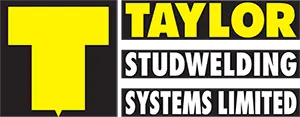


+44 (0) 1924 452123
sales@taylor-studwelding.com

As a specialised area of welding, stud welding has its own industry terms, as well as those that also crop up in other welding disciplines. Here we list all the stud welding terminology you need to know to become truly familiar with how people describe stud welding equipment and processes.
Basic Stud Welding Terminology
Stud
The fastener an operator can affix to a metal sheet using stud welding. Welding studs come in a range of materials, including stainless steel, mild steel, pure aluminium, aluminium alloy, lead-free brass, and copper.
Controller
The stud welding controller provides the voltage power for stud welding work. Our CD and DA controllers make it easy to set the welding time and current you need for highly standardised and accurate operations.

Stud Welding Controllers
Gun
The hand tool an operator uses to weld studs to a workpiece. We have a range of stud welding guns suitable for carrying out the main welding processes available in this area: capacitor discharge, drawn arc, and short cycle.
Parent Material
The sheet metal a stud is welded onto. Also called the workpiece. With stud welding, the strength of the resulting weld is often stronger than the stud and parent material combined. Different processes are suited to different parent materials, which include mild and stainless steel, pure aluminium and aluminium alloy, and lead-free brass.
Stud Welding Processes
Capacitor Discharge
Capacitor discharge stud welding is a cost-effective and fast process suitable for thin gauge sheet metals with clean and flat surfaces. This process works best with smaller diameter studs and causes minimal marking to the parent material, while welded CD studs require no finishing work. CD stud welding requires a single-phase power source and low-cost equipment and studs.
Drawn Arc
Drawn arc stud welding is a powerful process suitable for larger diameter welds on materials of 2mm and above thickness, including metals sheets with curvature or imperfections such as rust and grease. This process requires a 415-volt three phase power source and achieve very strong welds.
Short Cycle
This form of stud welding takes less time than drawn arc (taking from 10 to 100 milliseconds) but is more tolerant of surface imperfections than capacitor discharge, as well as hot rolled or coated materials. Short cycle is suitable for materials thicker than 1.7mm and can utilise CD studs, though it requires a three-phase power source as with drawn arc.
Other Stud Welding Terms
CNC
CNC stands for Computer Numerical Control. Computers can execute a sequence of pre-programmed tasks, automating processes traditionally done by hand. A CNC machine can have high levels of automation, making processes more rapid and exact. Many of our automated stud welding systems use a CNC to achieve welding rates of up to 60 studs per minute.

CNC Stud Welding Machine
Chuck
A stud welding chuck holds the stud in place within the gun before and during the CD process. All our machines require copper chucks, but we also manufacture brass chucks, as well as earth tag and nail chucks. We also make drawn arc chucks and auto feed chucks.
Ferrule
Drawn arc studs require ceramic ferrules to contain the molten metal created during the welding process and shape the resulting fillet.
Flux
Flux is an aluminium coating added to the weld end of a drawn arc welding stud to improve ignition and de-oxidise the weld pool.
Lift
The distance between the tip of the stud and the sheet metal when a lifting mechanism has been activated. Our specialist CD lift gap gun provides up to 5mm of lift for diverse applications.
Plunge
The axial movement of the stud towards the parent material.
Shrouding Gas
Using a shrouding gas (also called shielding gas) can improve weld spatter and is particularly useful for short cycle stud welding, where a ferrule isn’t needed to control the weld fillet.
Stud Diameter
The nominal diameter of the stud.
Welding Diameter
The diameter of the weld base.
Weld Pip
Our capacitor discharge studs have a small pip at the bottom of the stud, which makes contact with the sheet metal before welding occurs.
Welding Time
The time between initial ignition and extinction of the main arc.
Weld Zone
The area under the welded cross-section.
Stud Welding Terminology
Do you have a question about stud welding terminology or how stud welding can help your operations? Get in touch with Taylor Studwelding and we’ll be happy to help.





